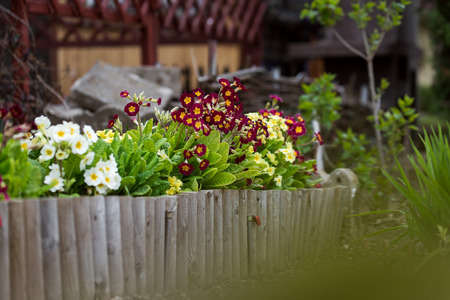Introduction to Perennials for Compact Spaces
If you’re passionate about creating a greener urban environment but limited by space, perennials are your go-to choice for container and small-space gardening in the U.S. Unlike annuals that need replanting each year, perennials come back season after season, reducing waste and conserving resources—a win for both your wallet and the planet. Choosing perennials means investing in plants that nurture local pollinators, enrich soil health, and require fewer inputs over time. This sustainable approach not only supports biodiversity but also aligns perfectly with eco-friendly values embraced across American cities. Whether you have a sunny balcony in Los Angeles or a cozy rooftop in Brooklyn, perennials help transform even the smallest spaces into vibrant, living ecosystems—proving that anyone can contribute to a more sustainable future, one container at a time.
Top Perennial Varieties for Containers
Choosing the right perennials is key to creating a thriving, sustainable container garden—especially if you’re working with limited space. Here, we explore a thoughtfully curated list of hardy, low-maintenance perennial plants that flourish in a variety of American climate zones. These selections prioritize pollinator-friendly blooms and water-wise options, making them ideal for eco-conscious gardeners looking to support local biodiversity and conserve resources.
Climate Zone Considerations
To maximize your gardening success, it’s important to select perennials that match your USDA hardiness zone. Below is a table highlighting top choices based on climate adaptability, pollinator support, and drought tolerance:
| Perennial | Recommended Zones | Pollinator Friendly | Drought Tolerance |
|---|---|---|---|
| Echinacea (Coneflower) | 3-9 | Bees & Butterflies | High |
| Coreopsis (Tickseed) | 4-9 | Bees & Butterflies | Medium |
| Lavandula (Lavender) | 5-9 | Bees | High |
| Sedum (Stonecrop) | 3-9 | Bees & Butterflies | Very High |
| Nepeta (Catmint) | 4-8 | Bees & Butterflies | High |
| Heuchera (Coral Bells) | 4-9 | Hummingbirds & Bees | Medium |
| Pennisetum alopecuroides (Fountain Grass) | 5-9 | Biodiversity Supportive (Habitat) | High |
| Dianthus (Pinks) | 3-9 | Bees & Butterflies | Medium |
| Aquilegia (Columbine) | 3-8 | Hummingbirds & Bees | Medium |
Sustainable Choices for Every Space
Selecting native or well-adapted species ensures resilience while reducing maintenance and resource input. For example, Echinacea and Coreopsis are North American natives that thrive in many U.S. regions, requiring minimal watering once established. Meanwhile, drought-tolerant options like Sedum and Lavender make excellent choices for water-wise gardening, supporting both pollinators and local ecology.
Biodiversity Boost: Pollinator Support Matters
The varieties listed above not only bring seasonal color and texture to small spaces but also create essential habitat for bees, butterflies, and hummingbirds. By prioritizing perennials with high ecological value, your container garden becomes a mini sanctuary—contributing positively to urban biodiversity while keeping your outdoor retreat vibrant and low-impact year after year.
![]()
3. Eco-Conscious Container Selection
When it comes to small-space gardening, choosing the right containers is just as important as selecting the best perennials. Sustainable pots not only help your plants thrive but also reduce your environmental impact. Here are some eco-friendly tips tailored for American gardeners who want to cultivate beautiful, green spaces while caring for our planet.
Opt for Recycled and Upcycled Materials
Look for containers made from recycled plastics, reclaimed wood, or upcycled metal. These options divert waste from landfills and often have a unique character that enhances your gardens aesthetic. Local thrift stores and community swaps can be treasure troves for finding gently used containers ready for a second life.
Choose Biodegradable or Natural Fiber Pots
Containers crafted from coconut coir, bamboo fiber, or rice hulls break down naturally over time, returning nutrients to the earth. These biodegradable choices are perfect for direct planting or starting perennial seedlings before transplanting them to larger pots or garden beds.
Prioritize Longevity and Plant Health
Select sturdy, non-toxic materials that stand up to seasonal changes—think terracotta, ceramic, or responsibly sourced wood. Ensure your pots offer adequate drainage to prevent root rot and promote healthy growth. Investing in high-quality containers reduces replacement frequency and conserves resources over time.
Support Local and Low-Carbon Producers
Whenever possible, buy from local artisans or U.S.-based manufacturers who use sustainable practices. This helps cut down on transportation emissions and supports your local economy—a win-win for both you and the environment.
By making thoughtful container choices, you create a flourishing perennial garden that reflects both American ingenuity and a commitment to environmental stewardship. Every pot you pick is an opportunity to nurture nature—right at home.
4. Planting and Care Best Practices
When growing perennials in containers or small spaces, eco-friendly care is key to long-lasting, healthy plants. Let’s dive into sustainable practices for soil mixes, natural fertilizers, and water conservation to maximize your garden’s potential while protecting our planet.
Eco-Smart Soil Mixes
Choosing the right soil mix sets your perennials up for success. Avoid peat-based products as their extraction harms fragile ecosystems. Instead, create a custom blend using local resources:
| Ingredient | Eco-Benefit | Recommended Proportion |
|---|---|---|
| Coconut coir | Renewable, excellent water retention | 30% |
| Composted leaf mold or homemade compost | Boosts nutrients & soil life, diverts waste from landfills | 40% |
| Pine bark fines or rice hulls | Improves drainage, renewable resource | 20% |
| Worm castings | Nutrient-rich, enhances microbial activity | 10% |
Natural Fertilizer Solutions
Synthetic fertilizers can leach chemicals into waterways—choose natural alternatives that nourish your plants and the environment. Try these sustainable options:
- Compost tea: Steep compost in water for a gentle nutrient boost.
- Fish emulsion: A quick-release option packed with micronutrients (look for sustainably sourced brands).
- Kelp extract: Improves root development and overall resilience.
- Coffee grounds or crushed eggshells: Add directly to soil for slow-release nitrogen and calcium.
Water-Saving Strategies for Small Spaces
Drought-tolerant perennials are a smart choice for container gardening, but every drop still counts. Use these American water-wise tactics:
- Add mulch: Top off pots with organic mulch (like shredded leaves) to lock in moisture and suppress weeds.
- Select self-watering containers: These reduce evaporation and ensure roots stay hydrated.
- Irrigate early or late: Water in the morning or evening to minimize loss from midday sun.
- Harvest rainwater: Set up a rain barrel for chemical-free irrigation; many U.S. municipalities offer rebates for installation.
- Group pots by water needs: Place thirsty plants together to streamline watering routines and prevent waste.
Sustainability Tip:
If you use tap water, let it sit overnight before watering—this allows chlorine to dissipate, which benefits both plants and beneficial soil microbes.
5. Incorporating Native Plants for Biodiversity
When selecting perennials for containers and small-space gardens, choosing U.S. native species offers a powerful way to support local ecosystems—even if you’re gardening on a compact balcony or patio. Native perennials are adapted to the specific climate, soil, and wildlife of your region, making them resilient and low-maintenance choices that thrive with fewer resources. By planting natives like Echinacea (coneflower), Rudbeckia (black-eyed Susan), or Asclepias (milkweed), you help create vital habitats for pollinators such as bees, butterflies, and hummingbirds right in your own urban oasis.
The Benefits of Growing Native Perennials
Native plants do more than just look beautiful—they play a crucial role in sustaining biodiversity. These perennials provide food and shelter for local insects and birds, many of which depend exclusively on native flora to complete their life cycles. For example, monarch butterflies lay eggs only on milkweed, while songbirds feed on native seeds and insects found among indigenous blooms. By including these plants in your small-space garden, you actively contribute to the health and balance of your community’s natural environment.
Resilience Through Local Adaptation
Because native perennials have evolved alongside regional weather patterns and pests, they require less water, fertilizer, and pesticide use compared to non-natives—making them an environmentally responsible choice for sustainable container gardening. Their deep root systems also help manage rainwater runoff, reducing soil erosion even in potted environments.
Creating a Nature-Friendly Haven Anywhere
No matter the size of your outdoor space, integrating native perennials turns it into a mini wildlife sanctuary where beneficial insects can thrive. This not only boosts pollination for your own plants but also supports neighboring gardens and green spaces in the urban ecosystem. Whether you’re new to gardening or looking to deepen your commitment to sustainability, choosing natives is a simple yet impactful way to nurture biodiversity—and enjoy a thriving, eco-friendly retreat at home.
6. Seasonal Care and Year-Round Enjoyment
Keeping your perennial containers looking vibrant and healthy all year long is easier than you might think—and it’s an eco-friendly way to garden, too! Here are some simple routines and sustainable tips to ensure your small-space perennial garden delivers continuous color, texture, and ecological value season after season.
Spring: Wake Up Your Containers
As temperatures start to rise, remove any winter mulch or protective layers from your containers. Prune back dead foliage to make room for new growth and add a top-dressing of organic compost to replenish nutrients. This is also a great time to divide crowded perennials and refresh the soil if needed. Water deeply but infrequently to encourage strong root systems.
Summer: Keep Things Lush
During the hot summer months, check your containers daily for moisture—container gardens dry out faster than in-ground beds. Mulch with natural materials like shredded leaves or bark chips to help retain water and keep roots cool. Deadhead spent blooms regularly to encourage more flowers and maintain a tidy look. If you’re growing native perennials, they’ll reward you with pollinator activity and resilience against pests.
Fall: Prepare for the Chill
As autumn arrives, remove faded annuals from mixed containers and trim back any declining foliage on perennials. Add a layer of organic mulch or straw around the base of plants to insulate roots against fluctuating temperatures. Now’s the time to plant late-season bloomers like asters for extended color, and collect seeds from mature plants for next year’s eco-friendly plantings.
Winter: Protect and Plan Ahead
If you live in a region with harsh winters, group containers together in a sheltered spot or wrap pots with burlap to shield roots from freezing. Evergreens and ornamental grasses add year-round structure and habitat for beneficial insects even during the dormant season. Take this quiet time to sketch out new planting ideas that support local wildlife and reduce resource use in the coming year.
Sustainable Tips for Year-Round Success
- Use organic fertilizers and compost instead of synthetic chemicals.
- Select perennial varieties that are native or well-adapted to your local climate for lower maintenance and higher ecological value.
- Rotate container locations if possible, allowing different areas of your patio or balcony to recover naturally.
- Collect rainwater in barrels for irrigation—better for plants and the planet!
Enjoying Eco-Friendly Beauty All Year
With mindful seasonal care, your container perennials will not only brighten up small spaces but also contribute positively to urban biodiversity. Every bloom supports pollinators, every leaf helps clean the air, and every sustainable choice makes a difference. Happy gardening—your green thumb is helping shape a healthier future!


